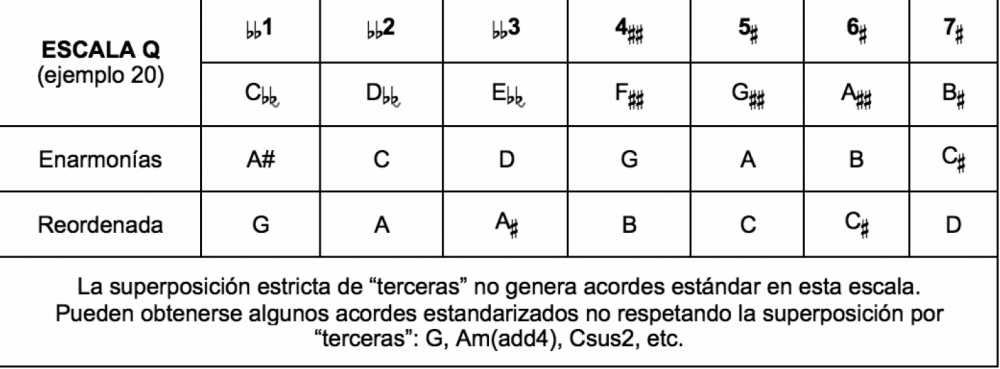Leaderboard
Popular Content
Showing content with the highest reputation on 08/25/2020 in all areas
-
My concept of this issue is that a scale (or a PC set) is a fixed photo of something. A mode is when you put that scale to work, dynamically, with relationships between chords you make and whatever (which is different from functional harmony). In a way you create a system with logic inside it, and that's what makes it work. Ah, with all there is.... why people stay always in the same language? My goal in music is to use anything: tonal, non-tonal. modal...... But looking for an expression, not easy, I know.2 points
-
Yes, in fact, any mode is a PC set... It's another focus on the same material. Nice.2 points
-
1 point
-
I've been doing some research on set theory since you pointed me toward it on the other thread. It's an interesting way to thing about organizing pitches. Another thought, if any mode can be thought of as a PC set, can any PC set be thought of as a mode???1 point
-
Ah ok. On the other hand, now you have two different degrees that are the same enharmonic note (Dbb and B# are both the same as C). I don't think this is really a problem, though, ultimately this is a pitch class set of six pitches with the form (0,2,3,4,5,7).1 point
-
@Luis Hernández That is neat. So it has a #4 as well as a natural 4 which sometimes happens in certain genres of folk music. It also has a minor 3rd and a major 3rd which is something I heard that Bartok likes to do.1 point
-
Well, the original scale has the 7 degrees without repetition. The second row are enharmonic pitchtes. The C# in the second row must be a C as you said, it's a mistake.1 point
-
1 point
-
Another excellent topic! I could go all day talking about modes. Yes, there are many who have described it this way. While it can certainly be useful, I would caution against taking it to the extreme where a certain mode is pidgeon-holed into a predefined degree of "brightness". I think other things like context and voicing play an understated role in how "bright" a mode feels, and its harmonic effect in general. While the video shows a couple of examples where lydian feels bright, depending on context lydian can feel very dark, at least to me. If you're interested I can post an example when I get home. There are of course countless possibilities, and even more if you don't restrict yourself to only 7-note scales. I've been recently experimenting with modes of the melodic major scale, and the 3rd and 4th modes of this scale (lydian augmented and lydian dominant) have my attention, at least for the moment. While the brightness scale can certainly be useful, it's also good to think of modes from the same parent scale as being in their own "family". Each mode of the major scale has it's own distinct character, but they all have certain quality that is similar between them due to being derived from same scale. Likewise for the melodic minor scale, the harmonic minor scale, and any other unique parent scale you can think of. Each of these families will has a unique character compared to other families. This makes it harder to use the brightness scale when comparing modes from different parent scales (at least for me). For example, a scale like lydian dominant has one raised (#4) and one lowered (b7) note when compared to the Ionian mode, so you might think there are roughly the same in terms of "brightness". But these two modes have a very different sound that I don't think can be described with simply "brightness". In the end you just have to judge the sound of the mode on its own merits and determine if it provides the sound you are going for. Modes are something I find very interesting, and something I spend a lot of time experimenting with. The resources I have found on Youtube and elsewhere have always left me wanting more, so it's good to see some discussion here. I think some people get too bogged down in analyzing what mode a certain piece may or may not be in (there are many Youtube videos going WAY in depth on this). Ultimately, a mode is just a theoretical concept - what's more important is finding creative and unique ways to make music with that concept, rather than following any preconceived "rules".1 point
-
Interesting. But I don't believe strictly in those starting points: sharps 0 happy, flats = sad. I told you that I was very interested in developing this world of the modes in a wider scope. Apart from the 7 eclesiastical modes... there can be hundreds. But the challenge is to make a mode sound different from the omnipresent major mode (and minor). That implies totally avoiding progressions that remind dominant-tonic. In fact, in modes we don't speak in those terms but cadential chords (instead of dominant). I wrote an entire book about how to manage any scale, in Spanish. Well, it was more to study this field. But here is an example: the Q scale (invented by me). The heptatonic scales must have the 7 degrees (C, D, E....) so this is the Q scale: Cbb, Dbb, Ebb, Fx, Gx, Ax, B# Enharmonicalle reordered is as you can see. Triads are not possible in the classic way. Modes provide infinite possibilities, even using two at a time... Or as in this case: make your own mode.1 point
-
The remarks regarding the contrabass double stops above standing ... I liked this piece. You actually wrote a pretty good transition back into F major from the D major area near the end. It didn't sound forced. Quite a chromatic piece.1 point
-
I was going to say the same, but maybe it's implied divisi? With that said, I liked this one. I think you would get a better effect if you gave the cello/viola some of the content of the bass. Harmonically I felt like there were some clashes, but it could be an orchestration thing idk. Overall, nice work! It's obvious you gave this one a lot of attention; I love the generally clean score. I'm excited to hear more from you and how your sound develops!1 point
-
When I compose, I rarely ever think about music theory - actually, though I took lessons in medium-to-advanced theory when I was younger, I feel like I utilize only the most basic music theory: not to use parallel fifths, know what the inversions are called, what some seventh chords are called, a little bit of polyphony, that sort of stuff. What I think about when I compose is really what works for the music emotionally, proportionately, melodically, and harmonically, and I try not to write in formal structures too much, unless that's my intention. My personal philosophy is that expressivity is more necessary for music than form, and that theory is just there to catalogue and taxonomize common mannerisms in music. Historically, this question seems to have been an issue for a while now, namely the Wars of the Romantics. You can observe this in the music of the Brahmsian faction vs. the Lisztian-Wagnerian faction, where the former seems to have valued theory and form before everything else, while the latter valued emotional expressiveness and weight to formal structure (though both sides had members who did things characteristic of the opposing front). At this point in time, though, it really boils down to what you feel is right for your music; for some it may be that form gives them more ground than fluidity, and vice-versa. As you continue writing music, you will learn what you feel is best for your music and you will adapt it into your writing. This is one step forward for you, learning that music is not all theory. And, just to remain consistent, just as all of what I have said is mine. 🙂1 point
-
“When one has reached maturity in the art, one will have a formless form. It is like ice dissolving in water. When one has no form, one can be all forms; when one has no style, he can fit in with any style.” - Bruce Lee also: "Adapt what is useful, reject what is useless, and add what is specifically your own." - Bruce Lee1 point
-
1 point
-
I wouldn't say the there's a problem with music theory, but rather your approach to it. I used to feel the same way, because what drives me as a musician is this ridiculous need to convey the sounds that I hear in my head to portray what I want to say. I used to start with music theory and try and fit ideas into it, but then I started letting that mental voice take charge, and using music theory to figure out where it's trying to go and what the actual goal is.1 point
-
1 point
-
Great question, it's interesting to see everyone's answers. Sometimes in my comfy chair with my laptop, and sometimes at my desk with my MIDI keyboard plugged into the laptop. I like to use the piano to improvise and explore ideas, and its convenient to be able to play them right into the DAW, but I'm starting to move toward just entering my ideas directly into the DAW. Back when I was in school I wrote mostly in Sibelius, but since I got back into this hobby about four years ago I've composed exclusively in the DAW, then I export the MIDI into Sibelius to make the score. Since my goal has always been to make a very good sounding audio file that's where I start. Then I worry about notating. I generally only compose for an hour or so if it's on a weeknight after work, but sometimes I'll go longer if I get up and write first thing in the morning on a weekend. I like to be able to stand up and pace around when I'm coming up with ideas (yeah I know a little weird), and sometimes I'll take care of laundry or dishes or something, if these kind of thinks count as "breaks". Sometimes. When I finished my last big piece I cooked myself a big juicy steak. I have a number of techniques I use to generate ideas from material I have already written. I also like to use qualitative descriptions of existing material to help lead me to how the next section should sound. For example, if I just finished an A section of a ternary form that is fast and staccato, and get stuck on the B section, I might commit to the B section being slow and legato. Or if I've finished one phrase of an A section and get stuck on the next, I might make a more subtle change to some of the qualitative descriptions of the existing material, like adding a few notes or changing the register of the melody. If I "lock in" a few parameters like this it helps eliminate some of the endless possibilities in front of me so I can focus on ideas that would work. Of course, no matter how many techniques you have you'll always hit a brick wall every now and then. When I do, I find something else to occupy my time for a few days or even a couple of weeks. Read a book, cook a new meal, hang out with friends, play a video game, explore other hobbies. It's very important to have a life outside of composing. Hopefully I can remember it 😂. Although I've learned that there's no such thing as a "golden" idea that would make my music perfect. I'm a believer that (almost) any idea can be shaped into something interesting, it's more about having the experience and tools to make them work. I try to stay toward the 1 end of the scale. Ideas don't flow as naturally when I'm stressed out.1 point
-
I don't have anything critical to say, so sorry for the lack of constructive feedback. I just wanted to say that I love this, it's something I would add to my playlist of songs I regularly listen to. Great work, and well done!1 point
-
Nice but staying so tonal and diatonal (if you can say so) makes itp predictable.1 point
-
Nice job Interesting harmonies. Sometimes the crescendo-explosions remind to Richard Strauss (Metamorphosen). I think all the parts and developments are justified. I would go over the legato-slurs (I prefer to writ "legato"). Also, those double stops in the double bass ... I think they're very hard.1 point



.thumb.png.8b5b433a341551e913a34392660bc95b.png)


